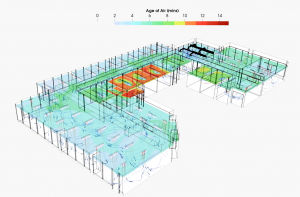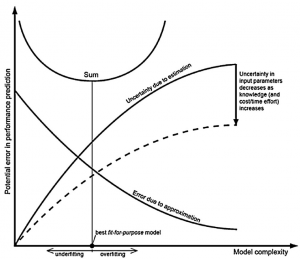Author: Graulich Lancelot Robert Benjamin Antoine
Have you ever experienced the wrath of an angry family member after opening a window, or worse, altering the living room fan speed in any way? Well, believe it or not, your relatives aren’t the only upset ones: indoor air quality engineers have been struggling for years to tackle the gap between design and operational conditions of ventilation.
Before detailing further, let’s define what design and operational stages mean when talking about indoor air quality (IAQ).
The design phase is everything that happens before the system is put in place inside a building. For engineers to choose the right ventilation system, research on the matter must be conducted, through experiments with multiple conditions. Then, the collected data is used to define the different types of air quality needs and solutions to fit them. Finally, the products need to be tested to guarantee their compliance with the interior space needs. When building or renovating, the usual design process involves computational fluid dynamics (CFD) models of the space where the ventilation device should be implemented.
On the other hand, the operational phase describes all events occurring once the ventilation system is placed inside the building. During this phase, the designers have little to no influence on the working device. However, the building occupants, through their behavioral choices, such as opening windows, changing fan speed, or daily activities like cooking and showering, have a considerable impact on IAQ. Furthermore, the occupants are not the only factor of divergence during the operational stage, and this issue has been observed for decades.
So, what are we getting wrong when designing indoor ventilation?
In this post, we will discuss the main identified causes of disruption. First, the challenges of modeling real environments, then the difficulty of predicting occupant behavior, and finally the cost-related issues of IAQ, both financial and energy-wise. For each topic, we will investigate recommendations to bridge the gap between design and operational phases.
Modeling real environments

The first issue to be addressed concerns the models used during the design phase. To ensure good functioning in operational conditions, those CFD models need to be as accurate as possible. However, many challenges come in the way of realistic models.
For example, the surrounding buildings or the window positioning has a very high impact on the effectiveness of a model. This is why many ventilation device constructors recommend considering the geographical location of a building, and even simply model the surroundings so that the predictions match with reality [2,3].
Still, the modern urban environment is always evolving, therefore modeling the surroundings during the design does not always guarantee a perfect model-reality match during the operational phase. Furthermore, the occupant choices such as the furniture layout can also have a great impact on the indoor air flow, up to a 30% difference between layouts. More behavioral parameters are detailed below.
It is also crucial for researchers and engineers to question the way IAQ parameters are studied, monitored, and modeled. In 2014, a study on particle exposure in indoor environments revealed that the chosen monitoring period could drastically affect the level of exposure [4]. When using the occupancy time rather than the total monitoring time (the latter being the most frequently used before 2014), the average PM2.5 mass concentrations observed in apartments were 30% higher. Therefore, a continuous effort on research to precisely identify the right parameters to measure and model is needed to optimize the design phase.
To counter the limited capacity of current modeling approaches, recent recommendations suggest to directly integrate IAQ parameters at early design stage of a building’s life cycle [5]. In addition, many recommendations gravitate around monitoring and predicting occupant behavior, which also raises many challenges.
Predicting occupant behavior

Indeed, direct occupant behavior, such as opening or closing windows, has a considerable impact on indoor ventilation, especially when considering passive ventilation, where differences up to 150% between prediction and observation are recorded.
As personal sensitivities are distributed among the population, occupant behavior can vary in terms of a plethora of parameters, including subjective parameters which are hard to model. The state-of-the-art method is to use occupant surveys, during post-occupancy research, which means when the building is functioning. Oftentimes, these surveys are often inconsistent and non-standardized, which curbs the data collection and aggregation between studies, and forces reliance on indirect and subjective metrics [5].
In the past 20 years, research has been conducted on more occupant-focused design and systems that could adapt to different behavioral patterns. However, the approach has varied through the years. For a long time, its has been commonly accepted in the research community that more complex models implementing processes such as CFD assisted with genetic algorithms would progressively bridge the gap between design and operational phases [6].
On the other hand, recent works have drawn eyes on the importance of fit-for-purpose design to bridge the discrepancy caused by occupant behavior [7]. After noticing that practitioners rarely have the means to use the overly complex models designed by researchers, this new approach values simpler models to avoid both underfitting and overfitting models, as shown on Figure 1.

Overall, the recommendations regarding occupant behavior assessment and prediction are to standardize methods of data collection and post-occupancy evaluation, as well as to systematize IEQ metrics into simpler indicators based on standardized criteria [5]. Furthermore, having the opportunity to integrate IAQ and occupant behavior earlier in the design stage may also help designing better buildings.
The cost of IAQ

Finally, it is important to address the cost of IAQ, as this parameter has a crucial relevance on the choice for indoor air systems. When talking about costs of IAQ, we consider both the financial constraint, which is the major concern of most building owners, as well as the energy efficiency, a hot topic which indirectly affects the overall cost on the life cycle of a building, especially during periods of energy crisis like 2023 in Europe.
First, operational costs of IAQ can be rather high for building owners, especially when using mechanical ventilation in large spaces like open-space offices. This financial aspect, coupled to poor documentation on the needs of such machines, may lead to owners neglecting maintenance of their ventilation systems, thus reinforcing the gap with the design system.
In addition, the public usually considers good IAQ incompatible with energy efficiency, as mechanical systems require energy to function. This leads to cheaper or under-efficient systems being put in place in buildings to save on energy costs. However, many solutions exist to achieve energy-efficient buildings coupled with good indoor environments, such as demand-controlled ventilation, or even passive systems allowing for natural ventilation [8].
Conclusion
A single reason can not be pointed to explain the gap between design and operational stage of IAQ. This phenomenon is rather caused by the interaction of numerous parameters, many of which are interfering between one another. The precision of models used during design, the assumptions made for the operational phase opposed to actual occupant behavior, as well as the cost-centered approach of IAQ and energy use are all responsible for this discrepancy that has been observed for decades. Fortunately, recent works have defined new fit-for-purpose approaches that are put to good use in recommendations for better, green-certified buildings.
With the recent interest for IAQ since the Covid-19 pandemic, and the rise of green certifications for buildings that include indoor air quality requirements, we can hope that this long-term battle will be over soon!
References
[1] Fu, X., Han, M. (2020). Analysis of Natural Ventilation Performance Gap between Design Stage and Actual Operation of Office Buildings.
[2] Kingspan (2023). Six Considerations When Specifying a Ventilation System, www.kingspan.com.
[3] Wargocki, P., Seppänen, O. (2022). Principles of Ventilation to achieve high IAQ.
[4] Wierzbicka et al. (2014). Quantification of differences between occupancy and total monitoring periods for better assessment of exposure to particles in indoor environments.
[5] Licina, D., Wargocki, P., Pyke, C., & Altomonte, S. (2021). The future of IEQ in green building certifications. Buildings and Cities, 2(1), pp. 907–927.
[6] Zhou, L., Fariborz, H. (2008). Optimization of ventilation system design and operation in office environment.
[7] Gaetani, I., Hoes, P.J., Hensen, J.L.M. (2016). Occupant behavior in building energy simulation: Towards a fit-for-purpose modeling strategy.
[8] Persily, A.K., Emmerich, S.J. (2012). Indoor Air Quality in Sustainable, Energy Efficient Buildings.